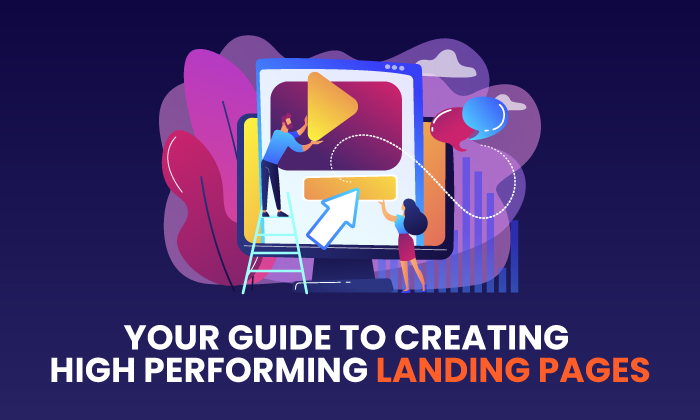
Looking to drive more conversions but not sure where to start?
Landing pages are a key component to increasing conversions online—no matter what your goals are.
What exactly is a landing page, and (more importantly) how do you create an effective one?
Below, I’ll cover landing page basics, including tips to create a better landing page design, and tools to streamline the landing page creation and testing process.
What is a Landing Page?
A landing page is a single webpage that serves a single purpose—usually to drive conversions. Unlike your homepage, which might list all the services your business offers, a landing page encourages users to take one, specific action.
Here’s a landing page example for my tool Ubersuggest:
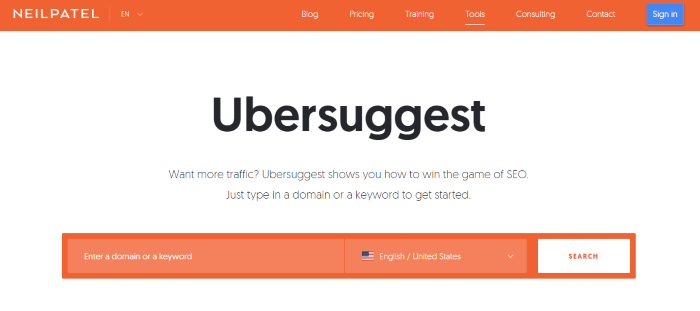
The page’s main goal is to encourage users to try out the tool by entering a domain or keyword. I also included a short description of what the tool does.
I’ve decided to keep the navigational buttons at the top, but many landing pages will choose to omit those entirely. I recommend testing both ways to see which drives more conversions for your business.
Why You Need Landing Pages
The main benefit of landing pages is to keep the user’s attention focused on one goal. They block noise and distractions that might pull users away from converting.
Here are a few other reasons why you need landing pages to succeed in digital marketing:
- More Data and Insights: By tracking traffic and behavior on your landing page, you get unique insights into acquisition, user behavior, etc.
- Improve Paid Ad Performance: Most paid ad platforms use a “quality score” to determine which ad to display. Ads that lead to relevant landing pages tend to have a higher quality score and thus are viewed more often.
- More Conversions: Landing pages focus on conversions above all else. This sole focus helps lead users in the right direction without distraction. Use them right, and your conversions will go up. (We’ll talk more about how to do this later!)
- Increase Brand Awareness: Landing pages use the same colors, tone, and logos as the rest of your website. This helps solidify your brand in the minds of customers and prospects.
Landing pages are also highly versatile. You can use them to increase email signups, drive sales, improve paid ad campaigns, and much more.
7 Tips for Creating Killer Landing Pages
Ready to create a landing page that drives business growth? These seven tips will help you create the high-conversion landing pages you’ve been dreaming of.
1. Include Clear Calls to Action on Your Landing Page
Call-to-actions (CTAs) are the most important part of your landing page.
Your call to action should be specifically tied to your goal and should be supported by everything else on your page, from the headline and body copy to images and overall layout.
Keep your CTA clear and make sure users know the next step. Here are a few CTA examples to test:
- Buy Now
- Sign Up
- Get My (X)
- Start Your Free Trial
- Book an Appointment
Avoid bland CTAs like “Submit” that don’t tell users what the next steps are.
2. Keep Forms on Your Landing Page Simple
If your page includes a form, make sure it only asks for the most important information. If you’re trying to get visitors to sign up for an email newsletter, make sure you’re just asking them for their name and email address. Don’t overcomplicate things.
If you’re asking them to buy, then ask for billing and shipping information, and include a confirmation screen before they place their order. Wait until after they’ve placed their order to ask for additional information.
Asking for too much information early on decreases the chances a user will complete the action you want them to take.
3. Ensure Landing Page Copy is Clear and Concise
Leave the creative turns-of-phrase for your blog.
Landing page copy should be clear, easy to read, and make a specific point. Use bullet points, headings, and bold font to make content easier to read.
It’s pretty safe to assume that most people who visit your landing page already have some interest in what you have to say since they’ve clicked through from a PPC ad or email. However, just because they’re interested when they arrive doesn’t mean they’ll stay interested if you don’t get to the point.
Every single sentence and word on your landing page should serve a purpose, and that purpose should be to support your call-to-action. If it doesn’t do that, cut it.
4. Include Vital Information Above the Fold on Your Landing Pages
While there’s a lot of debate as to the importance of “the fold” in web design, landing pages are one area where the fold is crucial.
Your CTA should be located near the top of the page, where someone can click it without having to scroll.
This doesn’t necessarily mean that your visitors won’t scroll down the page to read more information.
Hopefully, at least a small percentage of your visitors will be ready to buy as soon as they arrive on your landing page. Either because the email or link that brought them there already persuaded them, or because it’s not their first time visiting one of your landing pages.
5. Ensure Your Landing Pages Have the Same Look and Design as Your Campaign/Ads
If your page is tied to an email campaign or PPC campaign, make sure the landing page echoes the look and feel of the ad or email.
If the designs of the two are wildly different, your visitors may wonder if they’ve ended up in the right place. The easiest way to do this is to carry over fonts, images, and colors from your campaign to your landing page. This is especially important for paid ads, as it can increase your quality score.
6. A/B Test Your Landing Page
Finding the most effective landing page design is a matter of trial and error.
A/B testing means running two different landing pages and changing just one element to see which performs best.
For example, you might use two different images and see which one drives the most conversions.
A few other features to test include:
- CTA
- heading
- button size and placement
- number of form fields
- images
- right, left, or center column design
- colors
Just remember to test each variant one at a time—if you change five different elements, you won’t know which impacted conversions.
7. Use Minimal Images and Large Font on Your Landing Pages
Aim to use one or two images, no more. Visual clutter detracts from the message and CTAs.
Larger font sizes are also a good idea to keep visitors’ eyes focused on what matters and reduce eye strain. Just don’t go overboard and put everything in a headline-size font—no one wants to be yelled at.
The ideal line length for copy readability is 39 characters, so size your font (and column width) accordingly.
Landing Page Creation Tools
You could create your landing pages from scratch, but most of us don’t have the time or the expertise to spend hours coding every time we need something new.
The good news is, there are several tools that make landing creation super simple. Here are a few of my favorite landing page builders and why I like them.
1. Swipe Pages
Swipe Pages is a landing page tool dedicated to creating high-performance landing pages. Where other tools include basic landing page creation in addition to other tools, Swipe Pages focuses specifically on building the best landing pages.
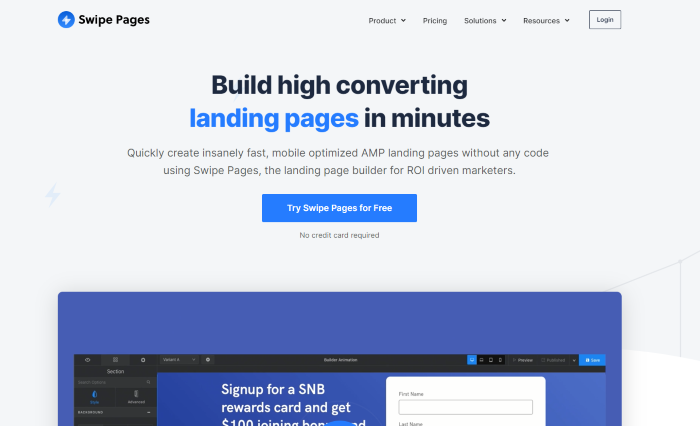
Features include tons of templates, a drag and drop editor, a countdown timer, and the ability to add features like forms, carousels, pricing tables, and more—without any coding.
They also offer A/B testing tools, dynamic text features, and faster loading times to give you an edge over your competition.
2. Hubspot
Hubspot offers a free landing page tool. Features include a library of mobile-optimized templates, drag and drop editors, forms, and plenty of customization options.
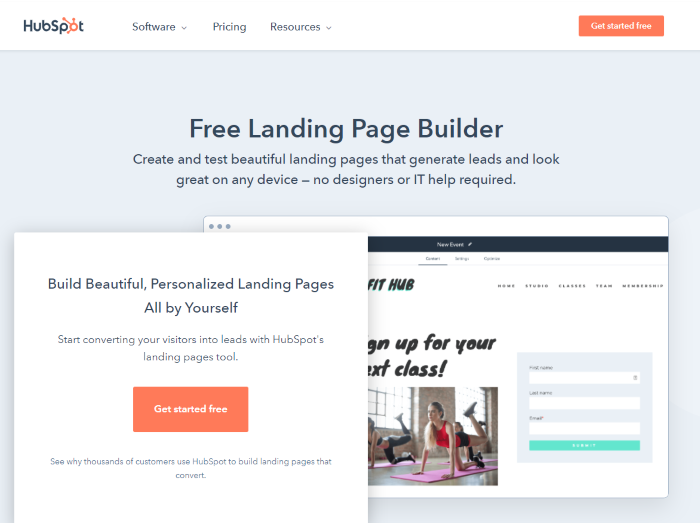
It’s worth noting the free version has limited features. You’re also limited to 20 landing pages with Hubspot branding, and can’t use a custom domain.
To get access to features like dynamic content, testing, and optimization features, you’ll have to pay for Hubspot. Paid plans start at $45 per month.
3. MailChimp
MailChimp is best known for their email marketing tools, but they also offer a landing page builder. Features include a wide range of templates, landing page analytics (such as visitors, clicks, and conversions), forms, and testing capabilities.
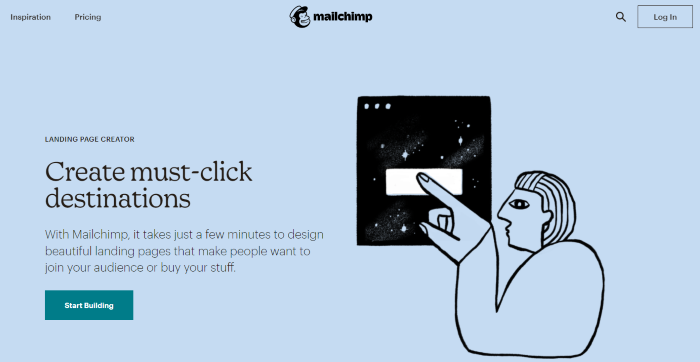
Mailchimp allows you to create unlimited landing pages for free, which is nice. But to access branding-free pages and additional features, you’ll need a paid plan, which starts at $11 per month.
If you already use Mailchimp for email marketing, it’s worth checking out their landing page tool.
Examples of Great Landing Pages
What makes a good landing page? The truth is, different strategies work for different businesses. Let’s take a look at three successful landing pages and discuss what works to give you some inspiration when creating your own.
We Can Code It
We Can Code It connects people with coding boot camps. This landing page is for an ad that displayed for the search “coding boot camps near me.”
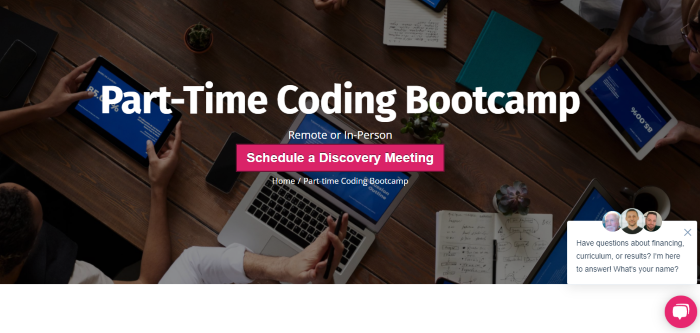
The landing page keeps it simple, with only a few lines of text. The image is a little busy, but the bright pink button stands out. The copy is clear and concise—there’s no question what they are promoting. I also like the pop-up chat box where users can get more information.
I do think the button text could be shorter—it’s a little long and not super clear. However, they might have tested and found this text drives more conversions!
SEMrush
SEMrush is an SEO platform, so I figured they’d have pretty solid landing pages. Here’s one for their tool that showed up as an ad in organic search:
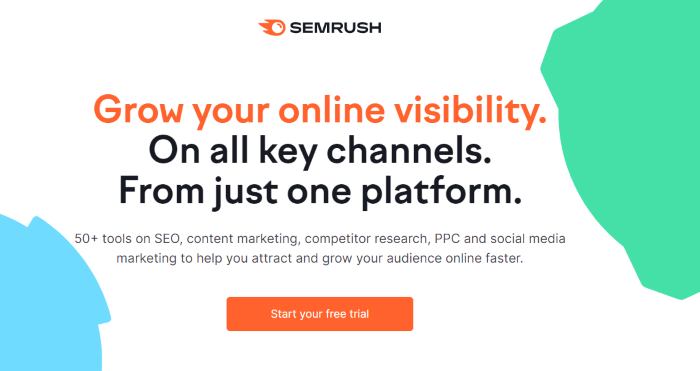
This one has more content than most landing pages, but the size differences make it easy to read. The button is bright (and on-brand) and makes it clear what your next step would be.
The main headline focuses on the benefit—grow your online visibility—and the third line focuses on another key benefit—you only need one platform. That’s appealing to marketers who are juggling a ton of tools.
Bullet Journal App
Here’s an example that breaks some of the rules, but still works well, in my opinion.
Bullet Journals are a popular style of journaling that helps users stay organized using lists. They also have a companion app. Here’s their landing page for the app:
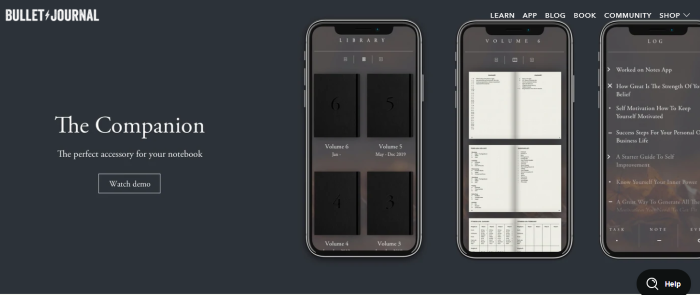
Like other landing pages, the content is limited. They use a heading, CTA, and images to show how the app works. Their CTA is “watch the demo,” which is a bit softer compared with what other brands typically use. I suspect they’ve done the research and realized that people on this landing page aren’t quite ready to buy.
The content is pretty sparse; they don’t describe what the companion is or what it does, really. However, I suspect that’s on purpose—people are pretty obsessed with their bullet journals, so page visitors already know what to expect.
This landing page is a perfect example of why A/B testing is crucial—you might be surprised about what works for your business.
Frequently Asked Questions About Landing Pages
Should you optimize your landing pages for SEO?
Yes, landing pages should be optimized to increase organic traffic. Even if your landing page is for a paid ad campaign, focusing on SEO can increase traffic and trust in your landing page.
What should a landing page include?
The main components of a landing page are a headline, subheadline, and CTA. Depending on your goal and what A/B testing tells you, a landing page might also include images, bullet points, etc.
Does Google like landing pages?
Google doesn’t inherently like or dislike landing pages. Landing pages do tend to have less content and fewer links, which are main search algorithm ranking factors. However, a well-optimized landing page can still rank well in organic search.
How many landing pages should you have?
Landing pages focus on just one goal, which means you should have one landing page for each goal. For example, you’d want a landing page for a free trial, a landing page for webinar sign-ups, a landing page for ebook downloads, etc.
Conclusion: High-Performance Landing Pages
Landing pages are a core component of online marketing. Whether you’re trying to gather email addresses, host webinars to gain leads, or want to sell more products, you need to get familiar with landing pages.
Here’s the thing most people don’t realize—landing pages can be really simple to create. Don’t spend hours debating which heading to use. Instead, use one of the tools listed above, create two versions of your landing page and let your A/B test run.
Get a winner, create a new test, rinse and repeat. Eventually, you’ll have a killer landing page.
Have you created a high-converting landing page? What change had the biggest impact on conversions?
from Blog – Neil Patel https://ift.tt/3vK3mdM

No comments:
Post a Comment